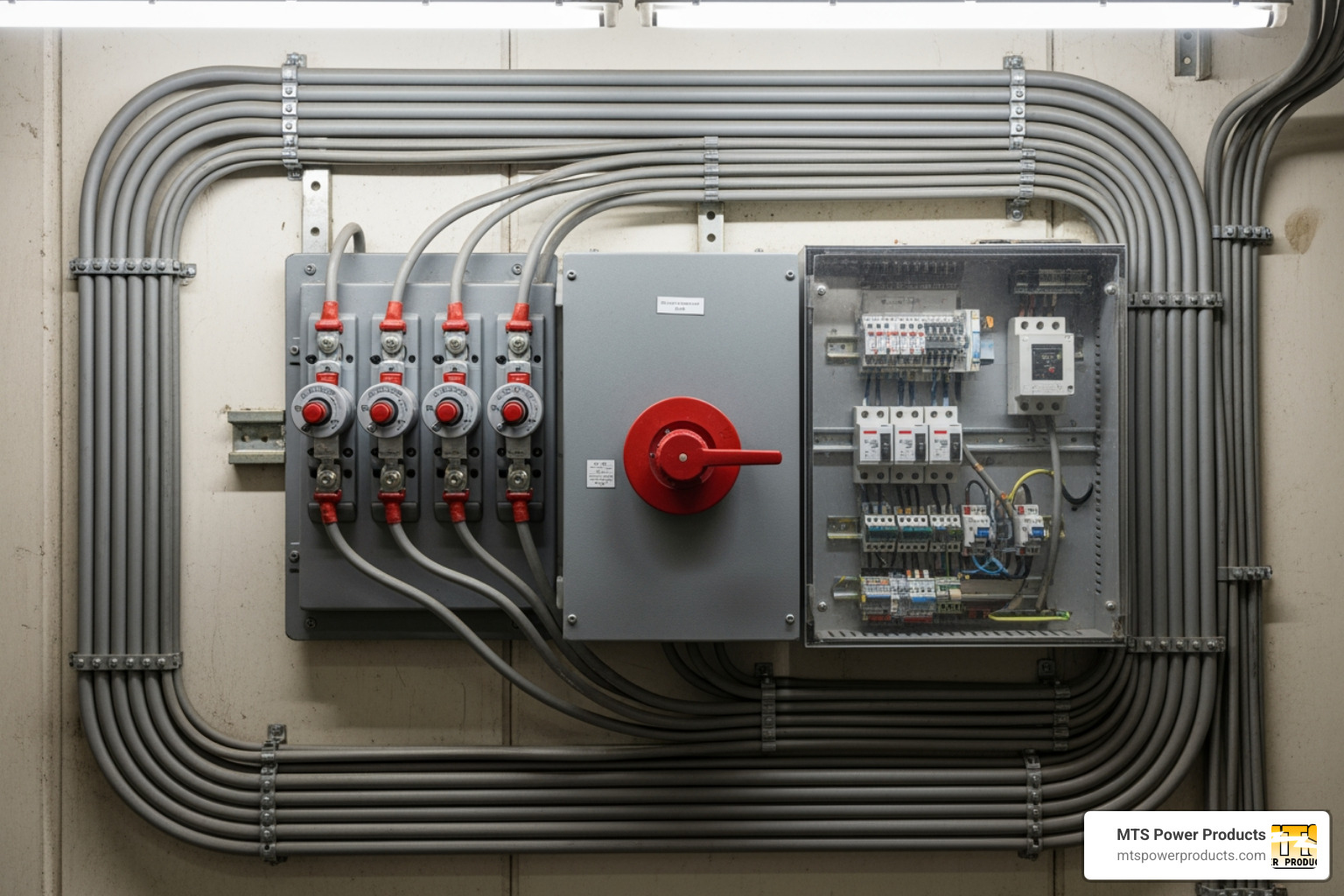
Buy Direct
from the Manufacturer
Sell our Products
Become a Distributor
Discounts
on volume purchases
Visit Us
at our Miami office
from the Manufacturer
Become a Distributor
on volume purchases
at our Miami office
Learning how to install a generator automatic transfer switch starts with understanding what makes this device critical for any backup power system. An automatic transfer switch (ATS) is the brain of your generator setup – it monitors your home’s electrical supply and automatically switches to generator power when the utility fails.
Here’s the complete installation process at a glance:
Why you absolutely need an ATS: Without one, connecting a generator to your home is both illegal and deadly dangerous. The transfer switch prevents “backfeeding” – electricity flowing backward into utility lines that can electrocute utility workers trying to restore power. It also protects your expensive appliances from power surges and prevents generator damage.
The installation process is complex and dangerous. Most sources rate it as a 5 out of 5 difficulty level, strongly recommending professional installation by licensed electricians. Installation typically costs around $2,000 including labor, with the work taking 4-6 hours to complete safely.
For facilities managers, an ATS ensures uninterrupted power that prevents costly downtime. For homeowners preparing for hurricane season, it means their family stays safe and comfortable when the power goes out.
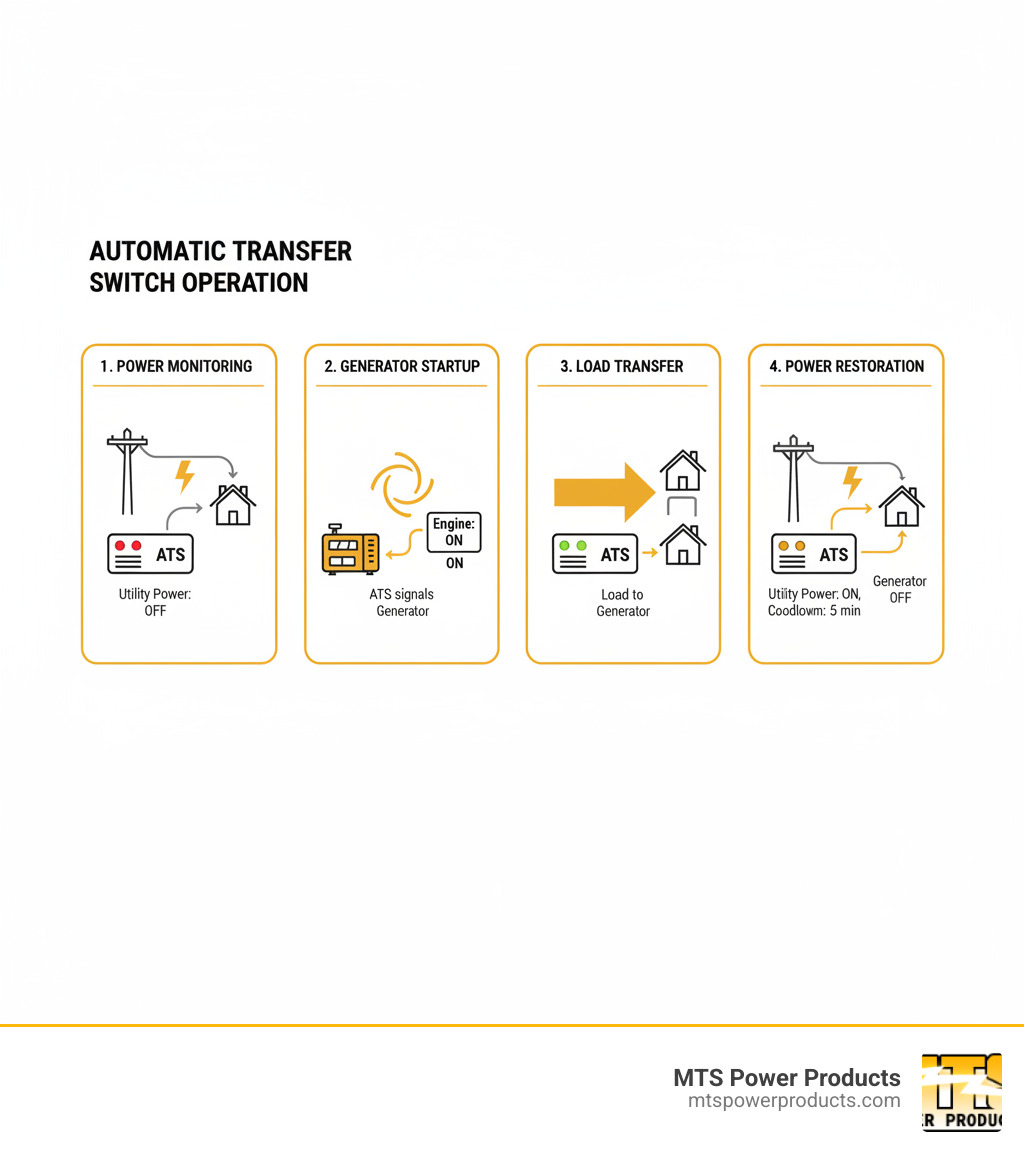
Quick look at how to install a generator automatic transfer switch:
This section covers the critical planning phase, emphasizing safety, cost, and why this is not a suitable DIY project. Installing a transfer switch is a difficult task (5/5 skill level) best left to licensed electricians.
Before starting, it’s crucial to understand the complexity, cost, and dangers involved with how to install a generator automatic transfer switch. This isn’t a simple DIY project; it involves your family’s safety and your home’s electrical system. While this project is for professionals, understanding the preparation process is valuable.
Not all transfer switches are the same. Understanding your options helps you choose the right one for your home and budget.
| Feature | Manual Transfer Switch | Automatic Transfer Switch (ATS) |
|---|---|---|
| Cost | Less expensive to purchase and install | More expensive, higher labor expenses due to complexity |
| Convenience | Requires manual operation during an outage | Detects outages and switches automatically for seamless power |
| Installation Complexity | Simpler, but still requires electrical expertise | More complex, typically a job for licensed electricians (5/5 difficulty) |
| Operation | You physically flip a switch to transfer power | Monitors utility power, starts generator, transfers load automatically |
Now, let’s discuss cost. A professional automatic transfer switch installation is a significant investment.
Professional labor costs typically start around $500, but that’s just the beginning. The ATS unit cost ranges from $400 to well over $1,000, depending on the features and capacity you need. When you add everything up – the switch, installation, permits, and any electrical upgrades – you’re looking at a total project cost of $2,000 or more. According to HomeAdvisor, installation can cost around $2,000, and that’s often on the conservative side.
The installation time runs 4-6 hours for a straightforward setup. This cost is an investment in safety, convenience, and peace of mind that pays dividends every time the power goes out.
At MTS Power Products, we’ve seen homeowners try to cut corners on transfer switch installations, and it rarely ends well. Our McPherson Controls line offers professional-quality systems with advanced features like remote monitoring, because when it comes to your family’s safety, you want equipment that won’t let you down.
Electrical work on your main panel is not a hobby project; it’s serious business with severe consequences if done incorrectly.
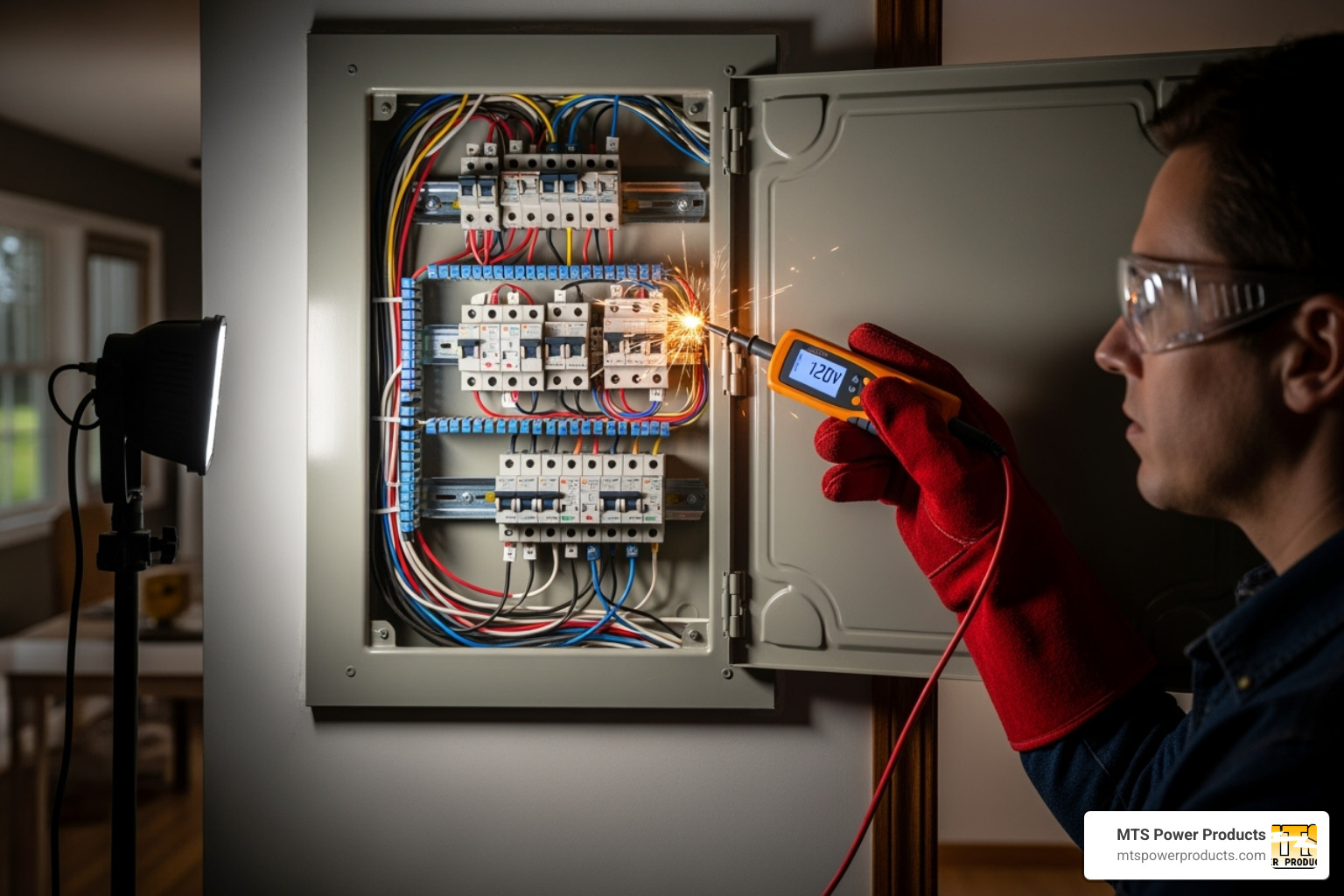
We strongly emphasize hiring a professional for this work. Installing a transfer switch earns a 5 out of 5 difficulty rating – that’s electrician territory. While this guide on how to install a generator automatic transfer switch gives you the knowledge to understand the process, it’s not meant as a DIY manual unless you’re a licensed electrician yourself.
The dangers are severe: electrocution, fire hazards, and carbon monoxide poisoning. The Federal Emergency Management Agency warns about these documented risks in their safety guidelines.
Always start by turning off main power and using a voltage tester to confirm everything is dead. Electricity doesn’t give second chances.
Generator placement is equally critical. Your generator must sit at least 20 feet from your home with proper ventilation to prevent carbon monoxide poisoning. Never run it in a garage, basement, or any enclosed space.
A professional electrician comes prepared with the right tools and materials. The essential equipment includes a voltage tester, wire strippers, screwdrivers with insulated handles, and conduit for protecting the wiring runs.
The materials list is equally specific: you’ll need the appropriate gauge wire for your system’s capacity, an electrical enclosure like this 12 x 12 x 6 – Home Depot option, weatherproof connectors, and mounting hardware.
Many people overlook local permit requirements. Most areas require permits for transfer switch installations to ensure they meet National Electrical Code (NEC) compliance. Your licensed electrician typically handles permit acquisition, but it’s worth contacting your local building department to understand the specific requirements in your area.
The permit process is a safety net that protects your investment and ensures everything is done right. The small permit fee is nothing compared to the cost of fixing a botched installation.
Now, let’s walk through the installation process. This guide is designed to help you understand the work a professional electrician performs when they install a generator automatic transfer switch. We’re sharing these steps so you can appreciate the complexity involved and have productive conversations with your electrician. This is for informational purposes only and is not a DIY manual.
A successful ATS installation starts with choosing the right location and mounting the unit securely to ensure functionality and accessibility.
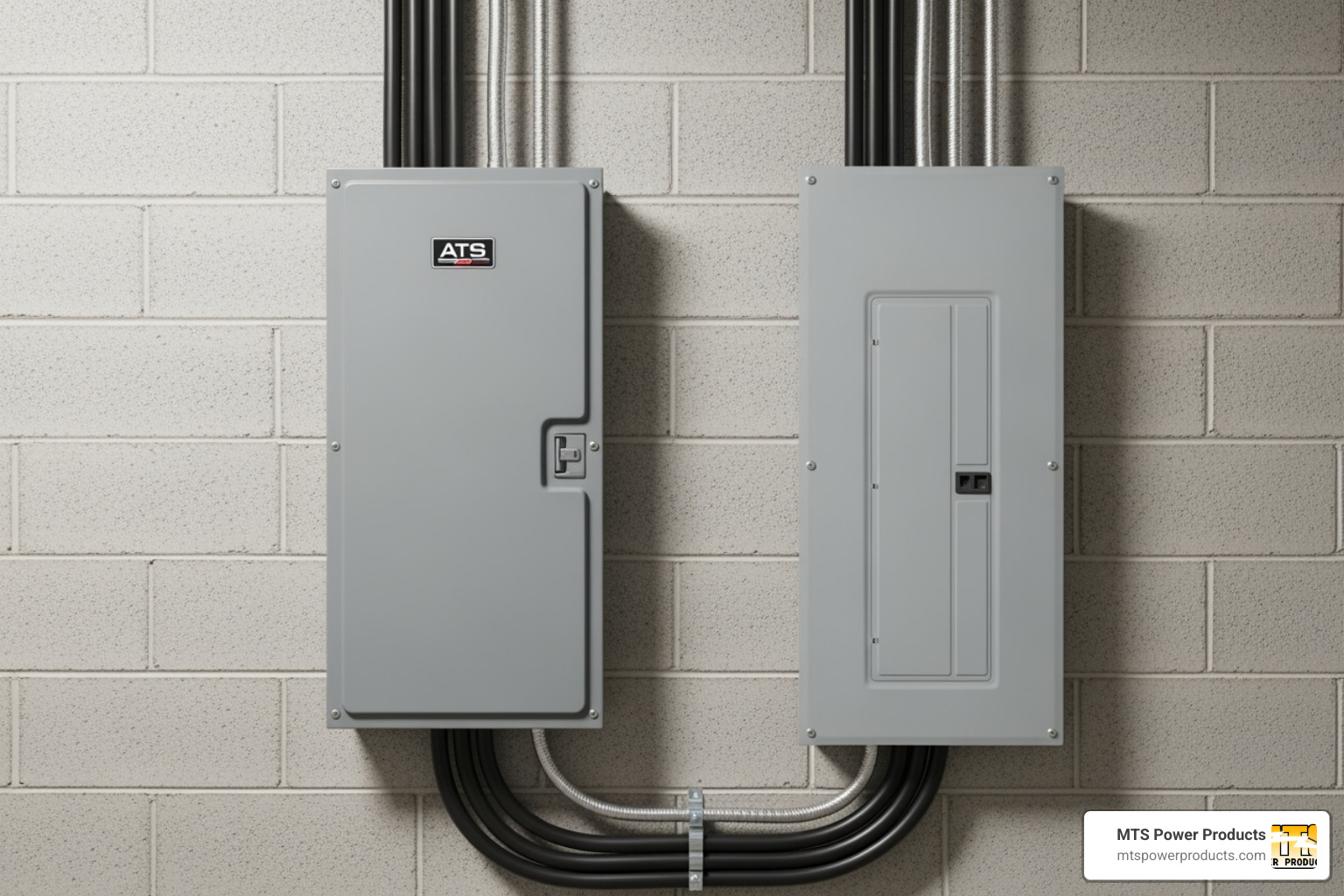
Location is key for ATS placement. The electrician will position the transfer switch near your home’s main electrical panel. Shorter wire runs reduce voltage drop and installation costs. The spot must be accessible for maintenance but away from daily household traffic.
Mounting the ATS enclosure requires precision. The electrician will mark and drill anchor points, securing the enclosure with appropriate fasteners. The enclosure must have the correct NEMA rating for its environment (e.g., a damp basement or outdoor location).
The exterior power inlet box, where the generator connects, must be mounted thoughtfully on an exterior wall. It should be at a comfortable height, allow for the 20-foot generator safety distance, and be weatherproof to withstand the elements.
This step integrates the ATS into your electrical system, enabling it to switch between utility and generator power.
Safety is paramount. The electrician will shut off the main breaker and use a voltage tester to confirm all power is off. Professionals treat every wire as live until proven otherwise.
Opening up your main panel allows the electrician to access your home’s circuits. Using their training and experience, they will identify circuits and plan their approach.
Critical circuits identified during planning (e.g., furnace, well pump, refrigerator, or internet router) are now addressed. The electrician disconnects these circuits from their breakers and reroutes them to the transfer switch.
Creating the power pathway involves running new wires from the ATS back to the original breakers. This creates a controlled loop where the ATS directs power from either the utility or the generator, preventing dangerous backfeeding.
This step connects the outdoor generator to the indoor electrical system via the power inlet.
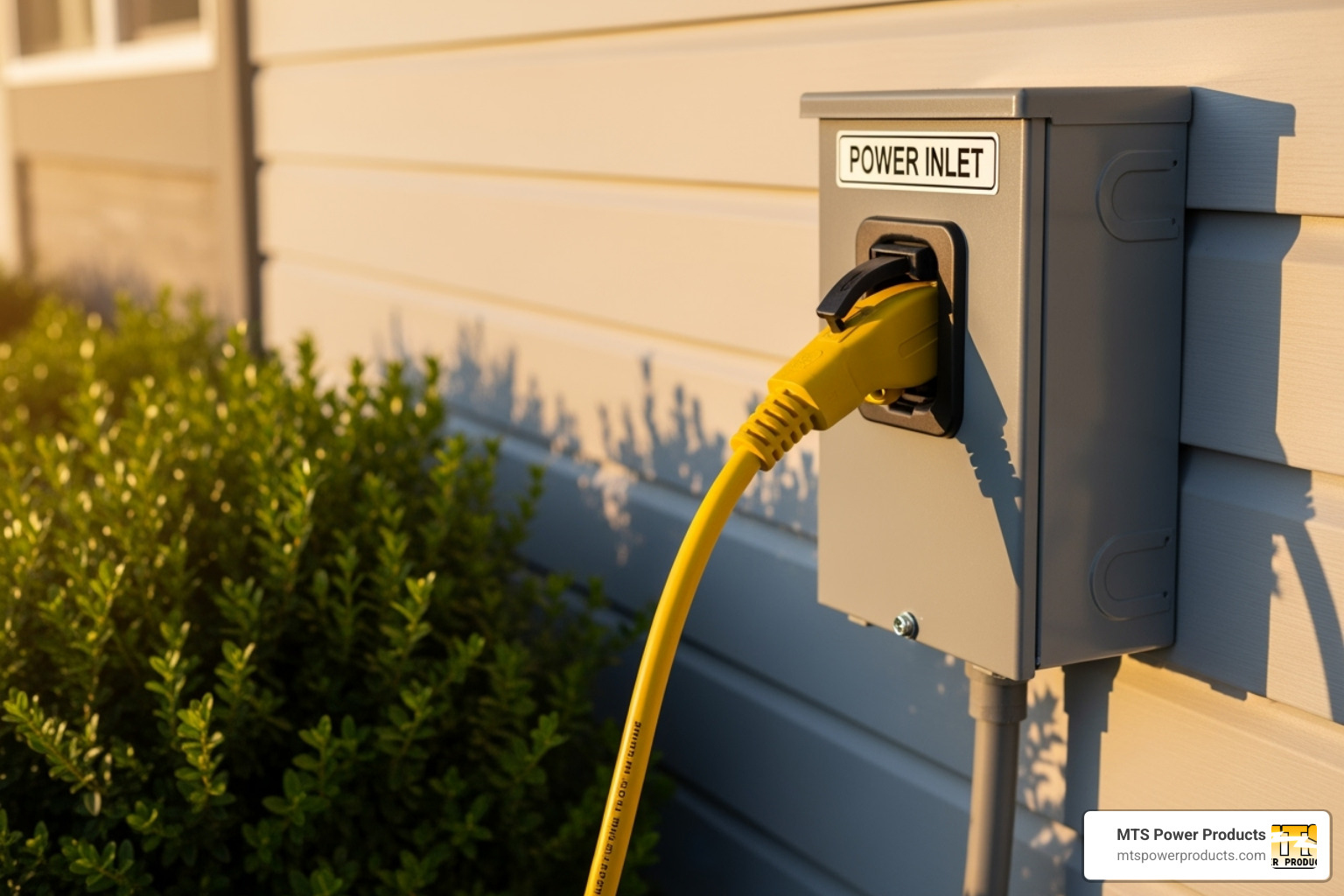
Drilling through your exterior wall requires planning to avoid structural elements, plumbing, and existing wiring. The hole must be correctly sized for the conduit and placed to avoid water intrusion.
Running conduit and wiring must meet code. Protective conduit shields the appropriately sized, heavy-duty cables from damage. Using quality wire prevents overheating and fire hazards.
Making the connections requires precision. Wires must be connected to the correct terminals in both the inlet box and the ATS, respecting color codes and torque specifications. Loose connections can create heat and lead to system failure.
Weatherproofing is critical, especially in Florida’s climate. The electrician will seal all penetration points. The inlet box must have gaskets and a cover to withstand sun and rain. Skimping on weatherproofing leads to failures.
This final phase involves making the last connections and inspecting the work to ensure the system will function flawlessly.
Generator control wires are the system’s nervous system, signaling the generator when to start and stop. These are critical for automatic operation. Our McPherson Controls units use advanced signaling for reliable communication.
Double-checking against manufacturer diagrams is a professional standard. Electricians follow schematics precisely to prevent operational failures or safety hazards. This step catches errors before they become problems.
Connection security is vital. The electrician checks every connection for proper tightness. Properly torqued connections prevent loosening due to thermal cycling (heating and cooling).
Replacing panel covers is a final safety step. Covers protect internal components from accidental contact, dust, and moisture, and help contain potential arc faults. The electrician ensures they are fitted and secured properly.
With the installation complete, the next step is testing the system.
After learning how to install a generator automatic transfer switch, the journey continues with testing and maintenance. Proper care ensures your ATS is always ready for action when you need it.
Testing is essential to confirm your generator automatic transfer switch will perform flawlessly during an actual outage.
Simulate a power outage by having your electrician turn off the main breaker. Ensure your generator is fueled, checked, and safely positioned at least 20 feet from your home. This mimics a real outage.
Your generator should start automatically after a brief delay. This delay prevents starts during minor power flickers. Hearing the generator start confirms your investment is working.
Watch for the transfer – once the generator provides stable power, the ATS will automatically switch the load to your selected circuits. A “clunk” sound during the switch is normal.
Now, go check your selected circuits. Verify that your lights, refrigerator, furnace, or other connected appliances are running on generator power.
Test the return to utility power – your electrician will turn the main breaker back on. The ATS should sense the stable utility power and automatically transfer the load back.
Finally, your generator should enter cool-down mode and then shut off. This period is crucial for the engine’s longevity, allowing it to cool down properly before shutting down.
Successful testing confirms your system is ready for a real power interruption. If everything works smoothly, you can have peace of mind knowing your backup power system is ready.
Like any sophisticated equipment, your ATS requires regular maintenance to ensure reliability. Fortunately, most of it is straightforward.
Monthly testing is recommended – give your system a workout once a month. Most ATS units have a “test” button that simulates an outage and runs the generator for a short period. This keeps your generator’s battery charged and ensures all moving parts stay functional.
Perform visual inspections – every few months, take a peek at your ATS enclosure (with the power off). Look for any signs of damage, loose connections, corrosion, or pests.
Keep the enclosure clean – keep the exterior of your ATS clean and free of debris. If dust accumulates inside, use a dry cloth or compressed air to clean it out.
Schedule professional annual inspections – while you can handle basic maintenance, we strongly recommend having a qualified technician perform an annual inspection. They can test all components, check connection tightness, and ensure everything still meets current codes.
At MTS Power Products, our McPherson Controls line is designed with maintenance in mind. The advanced features like remote monitoring help you keep tabs on your system’s health, while the high safety standards ensure reliable operation for years to come. After all, the best backup power system is one you can count on when you need it most.
Let’s address the questions we hear most often from homeowners considering an automatic transfer switch installation. These are the real concerns that keep people up at night – and we want to give you straight, honest answers.
We get it – you’re handy around the house, you’ve watched the YouTube videos, and you’re thinking about tackling this project yourself. While we’ve just walked you through how to install a generator automatic transfer switch, we need to have a serious heart-to-heart here.
DIY installation is technically possible for those with extensive electrical experience, but it’s extremely dangerous. This project earns a solid 5 out of 5 difficulty rating for good reason. We’re talking about working inside your main electrical panel with live wires that can kill you instantly.
The risks go far beyond just hurting yourself. Improper installation can cause house fires, damage expensive appliances, or even electrocute utility workers trying to restore power in your neighborhood. Due to these very real dangers, it’s highly recommended to hire a licensed electrician.
Think of it this way – the few hundred dollars you might save on labor isn’t worth risking your family’s safety or your home. A professional electrician brings years of training, proper tools, insurance coverage, and knowledge of local codes. They’ll also handle permits and inspections, saving you headaches down the road.
This is one of the most important decisions you’ll make, and getting it wrong can be expensive or even dangerous. The transfer switch must be rated to handle both your generator’s output and your home’s electrical load for the circuits you want to power.
Your electrician will perform what’s called a load calculation. They’ll add up the wattage requirements of all your essential appliances – your refrigerator, furnace, well pump, lights, and that coffee maker you absolutely can’t live without. Based on this total load, they’ll determine the required amperage for your ATS, whether that’s 100A, 150A, or 200A.
It’s not just about matching your generator’s size. You need to consider the actual demand of the circuits you’re transferring. For example, if you have a 10kW generator but only want to power a few essential circuits totaling 6kW, you don’t necessarily need a massive transfer switch.
Getting the sizing wrong goes both ways. Undersizing means tripped breakers and potential equipment damage. Oversizing means you’ve spent more money than necessary. This is another great reason to work with a professional – they’ll get it right the first time.
This is where we need to get very serious for a moment. Connecting a generator directly to your home without a transfer switch – often called “backfeeding” through a dryer outlet or similar connection – is both illegal and incredibly dangerous.
Here’s what can go wrong: Without a transfer switch, your generator sends electricity back into the utility lines. When utility workers arrive to restore power, they expect those lines to be dead. Your backfeeding generator can electrocute them. This isn’t theoretical – utility workers have died because of illegal generator connections.
Your equipment suffers too. Backfeeding can destroy your generator’s engine or alternator from overload. Power surges and unstable voltage can fry every electronic device in your home – televisions, computers, appliances, everything. We’re talking thousands of dollars in damage.
The legal and financial risks are real. This type of connection violates electrical codes everywhere. Your homeowner’s insurance could refuse to cover fire damage caused by improper electrical work. You could face fines from your local utility company.
Fire hazard is the final concern. Overloaded circuits and improper wiring create serious fire risks. House fires from electrical problems are devastating and often preventable.
The bottom line? A transfer switch isn’t just convenient – it’s absolutely essential for safe, legal generator operation. At MTS Power Products, our McPherson Controls transfer switches are designed with these safety concerns in mind, providing reliable protection for your home and family.
We’ve walked through quite a journey together, haven’t we? From understanding what an automatic transfer switch does to watching a professional electrician work their magic with wires and circuits. How to install a generator automatic transfer switch might seem daunting at first glance, but now you have a clear picture of what this crucial safety system involves.
Think about it this way: installing an ATS is like adding a smart security guard to your home’s electrical system. This guard never sleeps, never takes a coffee break, and is always ready to spring into action the moment your power goes out. It protects your home from dangerous backfeeding, your generator from overloads, and most importantly, utility workers who risk their lives to restore power after storms.
The investment in a quality ATS and professional installation isn’t just about convenience – though having your lights come on automatically during a blackout is pretty sweet! It’s about creating a safety net that gives you genuine peace of mind. Whether you’re facing hurricane season like our friends in South Florida or dealing with winter storms that knock out power for days, your ATS ensures your family stays safe, warm, and connected.
We’ve emphasized throughout this guide that while understanding the installation process is valuable, the actual work should be left to licensed professionals. The complexity, safety risks, and code compliance requirements make this a clear case where expertise truly matters. The typical $2,000 investment for professional installation is money well spent when you consider the alternative risks.
For those ready to take the next step, choosing the right partner makes all the difference. At MTS Power Products, we’re proud to offer professional-grade generator automatic transfer switches backed by our expertise as manufacturers right here in Miami. Our McPherson Controls line brings advanced features like remote monitoring and improved safety standards to both commercial and residential applications.
Located just minutes from Miami International Airport and the Port of Miami, we’re uniquely positioned to serve customers across South Florida and deliver worldwide. When you choose MTS Power Products, you’re not just buying equipment – you’re partnering with a team that understands the critical importance of reliable backup power in our storm-prone region.
Your power security is our mission. Let’s work together to keep your lights on, your family safe, and your peace of mind intact, no matter what Mother Nature throws your way.
